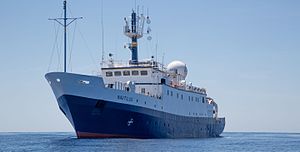EV Nautilus
 |
|
| History | |
|---|---|
|
|
|
| Name: | Nautilus |
| Builder: | Ps Werften Wolgast |
| Laid down: | 1967, East Germany |
| Renamed: | 30 July 2009 |
| Homeport: | Bodrum, Turkey |
| General characteristics | |
| Class and type: | Germanischer Lloyd 100 A5 E1 |
| Tonnage: | 1,249 gross, 374 net |
| Length: | 211 ft (64 m) |
| Beam: | 34.5 ft (10.5 m) |
| Speed: | 10 knots (19 km/h; 12 mph) |
| Complement: | 17 crew, 31 science/mission |
Exploration Vessel (E/V) Nautilus is a 64-meter research vessel currently based in Victoria, British Columbia. As FS "A. v. Humboldt" she was in service until 2004 for the Leibniz Institute for Baltic Sea Research Warnemünde (IOW). E/V Nautilus is on a global mission of exploration, so it has no true home port. The ship is operated by the Ocean Exploration Trust under the direction of Dr. Robert Ballard, the man who is known for finding the wreck of the Titanic and the German battleship Bismarck. Nautilus is equipped with team of remotely operated vehicles (ROVs) Hercules, and Argus, a multibeam mapping system, and mapping tools Diana and Echo. All of these tools help the Ocean Exploration Trust conduct deep sea exploration of unknown parts of the ocean to a depth of 4000 meters.
E/V Nautilus also has a SeaTel satellite communication system to facilitate live streaming telepresence-enabled outreach and scientific collaboration. Video and data streams are managed through the Inner Space Center (ISC) at the University of Rhode Island's Graduate School of Oceanography. Live footage of exploration at sea can be viewed at www.NautilusLive.org during the expedition season. Around the world, various museums, science centers, after-school programs and schools participate in exploration through live ship-to-shore broadcasts. Audiences online or live at a partner venue can submit questions to the team of explorers, the Corps of Exploration, to learn more about the mission and excitement of exploration. Educational opportunities exist to bring scientists, students, educators and interns onto the ship to learn with the Corps of Exploration every exploration season.
Hercules is the primary vehicle of a two-body ROV system. Hercules is rated to a depth of 4,000 m, and is always deployed with Argus. It is equipped with cameras, lights, instruments, manipulators, and a wide array of sampling tools, The primary camera is a high definition system augmented by six standard-definition cameras. Four lights (over 60,000 lumens total) illuminate the forward working area, while smaller incandescent lights provide auxiliary illumination. Standard instrumentation includes a fast profiling conductivity-temperature-depth (CTD) sensor, an oxygen probe, two high-resolution scanning sonars, a 1.2 MHz multibeam sonar and a high resolution stereo still camera system. The primary manipulator is an arm with force feedback, complemented by a seven-function manipulator for sample collection. Hercules is also equipped with a number of tools, including a suction sampler, sampling boxes with actuating trays, and sediment coring equipment, as well as several other purpose-built tools for different scientific objectives. Using a navigation system in tandem with ultra-short baseline positioning, Hercules is capable of maneuvering and hovering on a centimetre-scale grid.
...
Wikipedia
